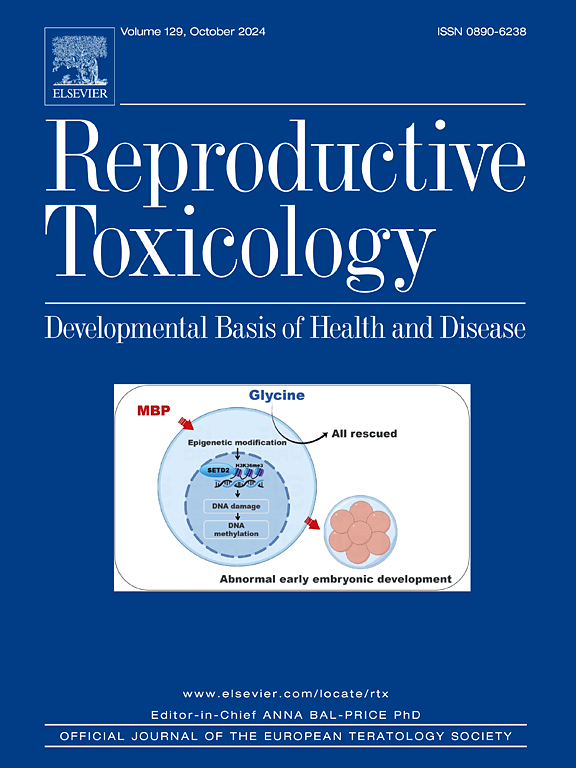The impact of fluoxetine treatment on reproductive organs in male rats following peripubertal PTSD-like stress exposure
IF 2.8
4区 医学
Q2 REPRODUCTIVE BIOLOGY
引用次数: 0
Abstract
Fluoxetine (FLX) is the primary treatment for childhood posttraumatic stress disorder (PTSD); however, it may exacerbate the impact of stress on the development of the male reproductive system. In this study, using a PTSD rat model, we evaluated the long-term effects of peripubertal stress and FLX treatment on the morphophysiological parameters of the testes and epididymis, as well as the levels of hormones that regulate male reproduction. Male 40-day-old rats were subjected to a stress-restress paradigm, followed by 21 days of FLX treatment (10 mg/kg). Behavioral testing confirmed PTSD-like anxiety in stressed rats. The PTSD rats exhibited significant reductions in serum testosterone and follicle-stimulating hormone (FSH) levels irrespective of FLX treatment. Although stress alone did not significantly reduce the sperm count, stressed and FLX-treated rats exhibited decreased sperm numbers, lower epididymis weights, and greater gonadosomatic indices. Histological analyses revealed testicular damage, including peritubular edema, disrupted seminiferous epithelium, and vascular congestion, in both PTSD and PTSD+FLX rats. These effects were more pronounced in the testes of the FLX-treated group, as evidenced by a significant reduction in the numbers of Sertoli cells and spermatogonia and an increase in the number of vacuoles. RNA sequencing revealed only modest gene expression alterations, which were primarily limited to the effects of stress. Thus, our results highlight the detrimental impact of FLX on male reproductive function, particularly in the context of PTSD-induced hormonal dysregulation. Although FLX is widely used for treating PTSD and other psychiatric disorders, its effects on reproductive health underscore the need for a cautious approach when prescribing the drug to adolescents.
氟西汀治疗对青春期ptsd样应激暴露后雄性大鼠生殖器官的影响。
氟西汀(FLX)是儿童创伤后应激障碍(PTSD)的主要治疗药物;然而,它可能会加剧压力对男性生殖系统发育的影响。本研究采用创伤后应激障碍大鼠模型,评估了青春期应激和FLX治疗对睾丸和附睾形态生理参数以及调节雄性生殖的激素水平的长期影响。40日龄雄性大鼠进行应激-应激模式,随后给予21天的FLX治疗(10mg/kg)。行为测试证实了应激大鼠的ptsd样焦虑。创伤后应激障碍大鼠表现出血清睾酮和卵泡刺激素(FSH)水平的显著降低,与氟哌啶治疗无关。虽然单独应激没有显著降低精子数量,但应激和氟替尼处理的大鼠表现出精子数量减少、附睾重量降低和性腺指数升高。组织学分析显示,创伤后应激障碍和创伤后应激障碍+FLX大鼠的睾丸损伤包括小管周围水肿、精原上皮破坏和血管充血。这些影响在flx治疗组的睾丸中更为明显,证据是支持细胞和精原细胞数量显著减少,液泡数量增加。RNA测序显示只有适度的基因表达改变,这主要局限于压力的影响。因此,我们的研究结果强调了FLX对男性生殖功能的有害影响,特别是在创伤后应激障碍引起的激素失调的背景下。虽然FLX被广泛用于治疗创伤后应激障碍和其他精神疾病,但它对生殖健康的影响强调了在给青少年开处方时要谨慎对待的必要性。
本文章由计算机程序翻译,如有差异,请以英文原文为准。
求助全文
约1分钟内获得全文
求助全文
来源期刊

Reproductive toxicology
生物-毒理学
CiteScore
6.50
自引率
3.00%
发文量
131
审稿时长
45 days
期刊介绍:
Drawing from a large number of disciplines, Reproductive Toxicology publishes timely, original research on the influence of chemical and physical agents on reproduction. Written by and for obstetricians, pediatricians, embryologists, teratologists, geneticists, toxicologists, andrologists, and others interested in detecting potential reproductive hazards, the journal is a forum for communication among researchers and practitioners. Articles focus on the application of in vitro, animal and clinical research to the practice of clinical medicine.
All aspects of reproduction are within the scope of Reproductive Toxicology, including the formation and maturation of male and female gametes, sexual function, the events surrounding the fusion of gametes and the development of the fertilized ovum, nourishment and transport of the conceptus within the genital tract, implantation, embryogenesis, intrauterine growth, placentation and placental function, parturition, lactation and neonatal survival. Adverse reproductive effects in males will be considered as significant as adverse effects occurring in females. To provide a balanced presentation of approaches, equal emphasis will be given to clinical and animal or in vitro work. Typical end points that will be studied by contributors include infertility, sexual dysfunction, spontaneous abortion, malformations, abnormal histogenesis, stillbirth, intrauterine growth retardation, prematurity, behavioral abnormalities, and perinatal mortality.
 求助内容:
求助内容: 应助结果提醒方式:
应助结果提醒方式:


